Quick pickled onions instantly transform salads, bowls, and sandwiches with a burst of flavor. They’re an easy way to elevate vegan meals! My go-to recipe takes only 10 minutes to prepare. It’s easy and reliable, and I share options to use it with other vegetables, too.
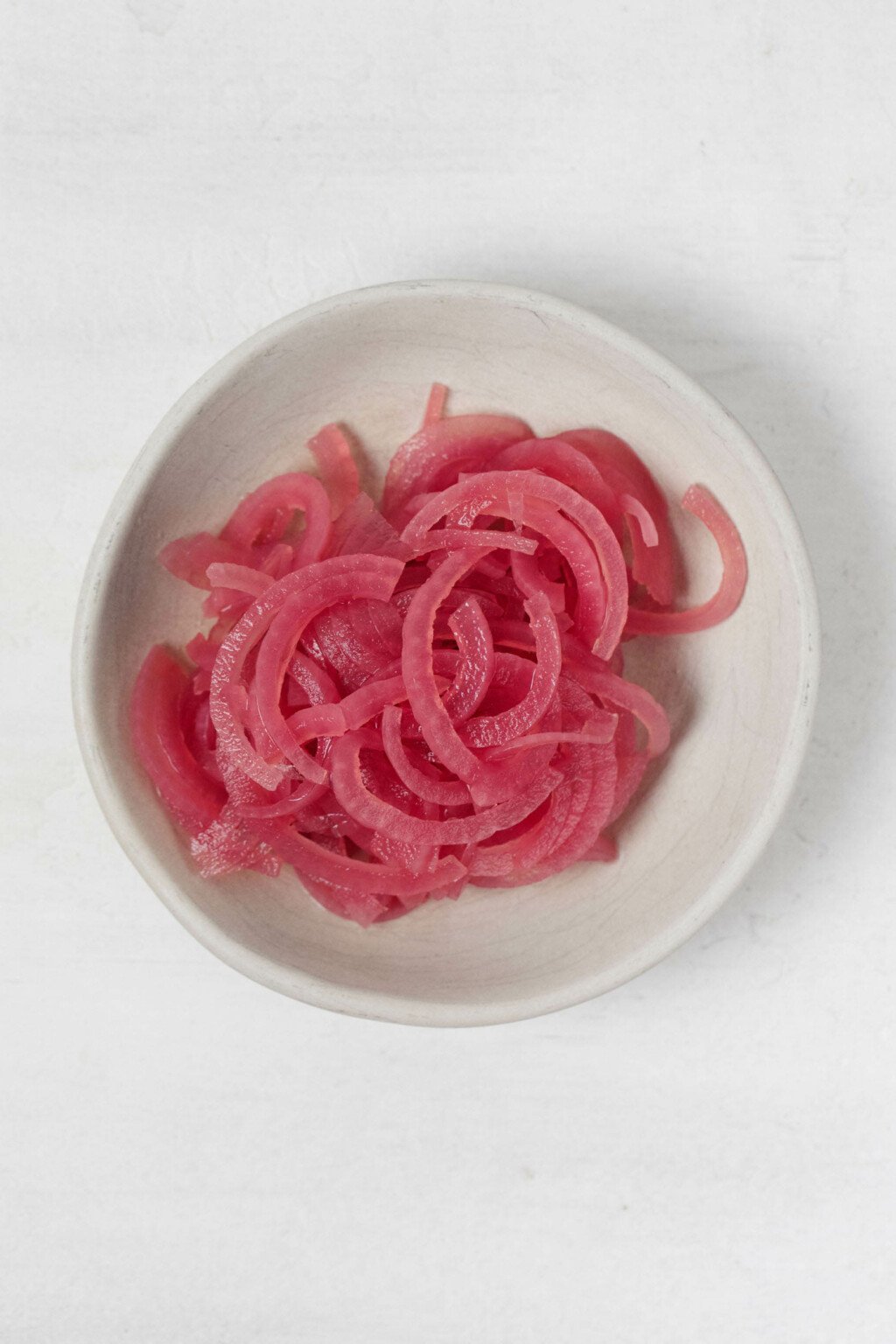
If the past week has involved any amount of holiday cooking, you may find yourself in need of a week off.
My Thanksgiving week actually didn’t involve any cooking. But it did involve a sincere effort to slow down, take a few days off, and savor time with my mom.
For me, this also meant a break from the kitchen. I worked on defrosting a lot of what I already had at home. This included some vegan chick’n, some bagels for sandwiches, a store-bought frozen pizza, and two burritos.
In my freezer there are usually some random portions of cooked grains, beans, tempeh, or tofu from past weeks of vegan meal prep. It’s easy to turn these ingredients into simple vegan lunch bowls.
And those lunch bowls are better when quick pickled onions are involved.
If any ingredient deserves to be labeled as a flavor hack, it’s quick pickled onions. They contribute acidity, saltiness, and the savoriness of onion. However, they’re much more mild than raw onion, which can “repeat” on one, as my mom used to say, for hours after a meal.
I reference quick pickled onions often on this blog, but I have yet to actually share my go-to recipe. I’m fixing that today.
What are quick pickled onions?
Quick pickled onions are onions that have been soaked in an acidic pickling liquid and refrigerated until they’re eaten.
Usually, quick pickled onions have been sliced thinly prior to pickling.
What’s the difference between quick pickling and long pickling?
What, exactly, makes quick pickled onions quick?
The “quick” designation refers to the fact that these onions are soaked in pickling liquid, then transferred to the fridge.
In fact, quick pickling is sometimes called “refrigerator pickling” instead.
With traditional—i.e., long—pickling, pickles are put through a canning bath and then canned. They become shelf stable through canning, which means that the can be stored for long periods of time.
Quick pickled onions, on the other hand, along with all quick pickled vegetables, should be consumed within about 2-4 weeks. (Some guides say that quick pickles keep for up to 2 months, but I eat them sooner, just to be on the safe side.)
The pickles need to be kept cold through their entire storage time.
Here’s the other “quick” thing about quick pickled onions: they’re quick to make!
Even fifteen minutes in pickling liquid, especially if that liquid is hot, will be enough to soften the onions, remove some of their “bite,” and season them a little.
The longer you allow the quick pickled onions to rest in the fridge, the more flavorful they’ll be.
What do quick pickled onions taste like?
Speaking of flavor, you can expect quick pickled onions to have some of the pungency of regular onions.
However, they’ve got less of a spicy quality than regular raw onions, and I think that they tend to have less of an aftertaste.
Because quick pickled onions are made with an acidic pickling liquid, they tend to be tangy and sharp. Pickling liquid is salty, so the onions can also add a salty dimension to food.
You have the choice to add some sugar to pickling liquid, and I usually do. This helps to offset all of the vinegar that’s used, and it can give quick pickled onions a slight sweetness.
How to make quick pickled onions
My favorite thing about refrigerator pickling is how incredibly easy it is. There are only a few steps toward zippy vegetable goodness.
Step 1: slice your onions
You can use a food processor, mandolin, or a good, old-fashioned chef’s knife to thinly slice your onions for pickling.
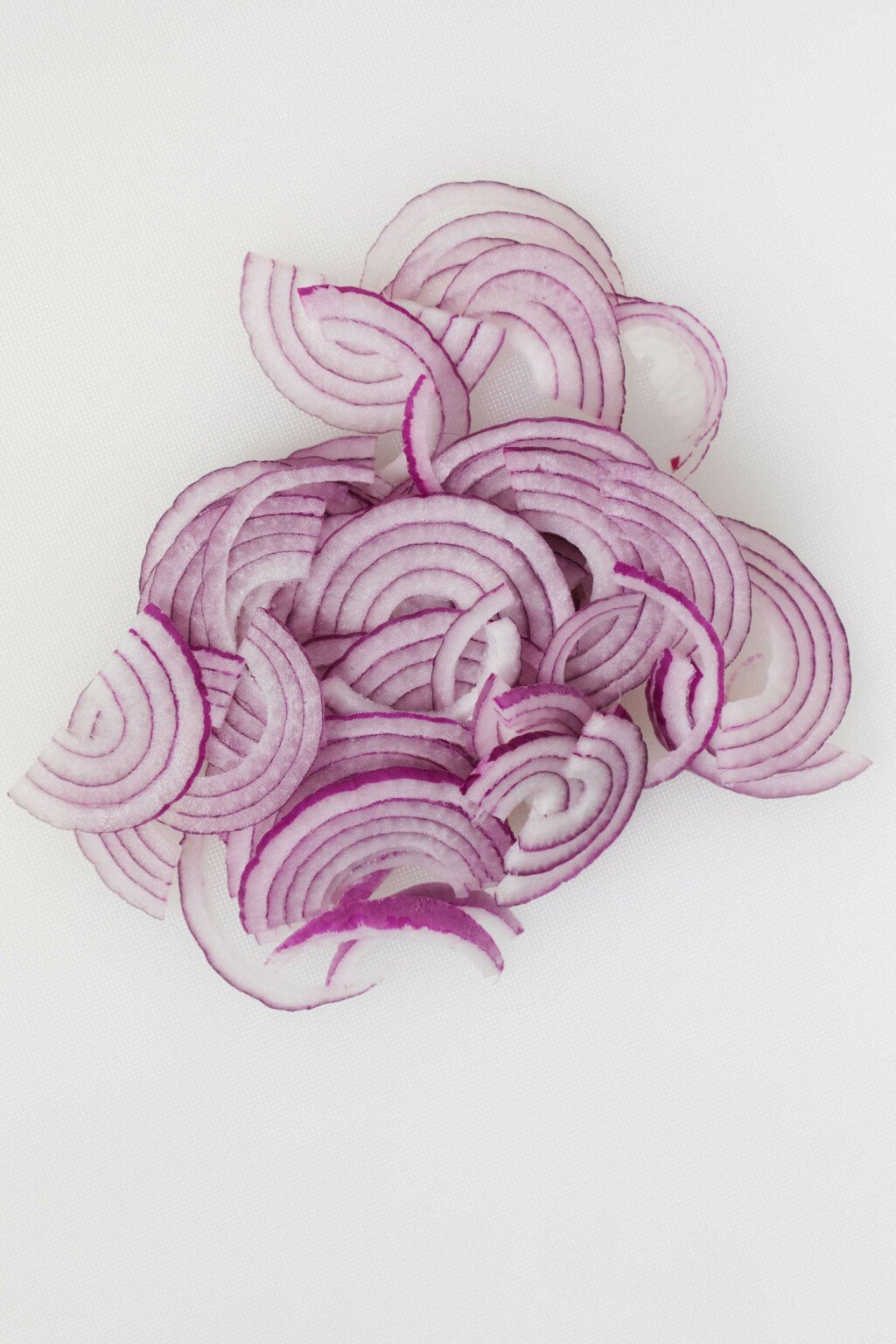
Step 2: making pickling liquid
Liquid for quick pickles is usually made with a combination of vinegar, water, and salt.
The vinegar can be distilled white vinegar, apple cider vinegar, white wine vinegar, or rice vinegar.
I usually use white vinegar or apple cider vinegar to make pickles. This recipe calls for apple cider vinegar, but you can use any of the above instead.
I think that it’s essential to use enough salt in pickling liquid. Salt will lend character and flavor to the onions, or to any vegetable that you’re choosing to pickle.
Finally, I do prefer to add a little sugar to my pickling liquid. I don’t add a lot, but the slight sweetness that sugar imparts helps to balance the flavor of the onions. You can omit the sugar in this recipe if you prefer to.
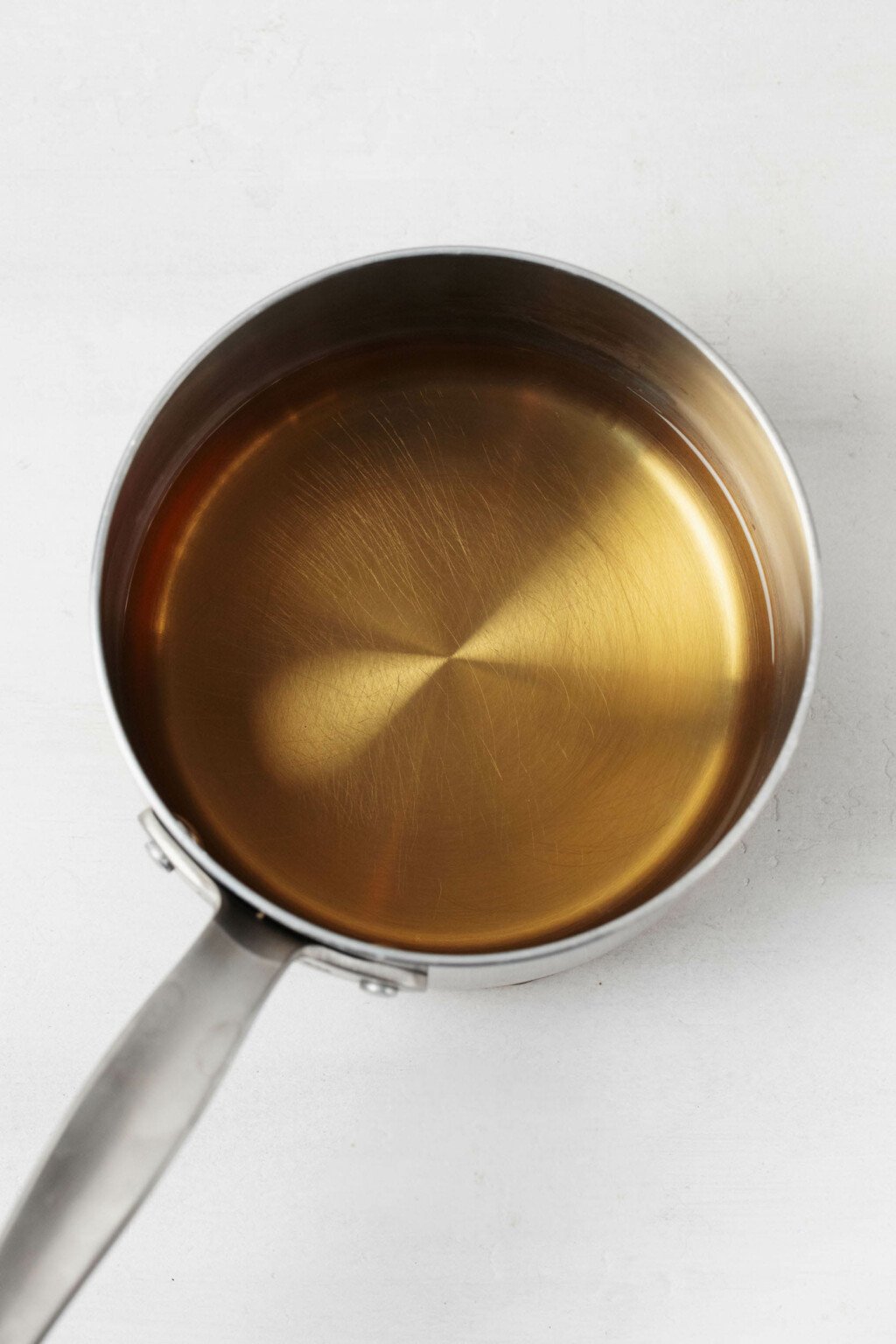
To heat or not to heat?
I choose to bring my pickling liquid to a simmer before pouring it over my thinly sliced onions.
This isn’t an essential step in the process—technically, you can make a quick pickle with cold pickling liquid. That’s especially true if the quick pickle has plenty of time in the fridge. Over the course of days, the pickling liquid will continue to soften and flavor your onions.
However, I think that heating the pickling liquid does two things. First, it helps to dissolve salt and sugar into the vinegar and water.
Second, it helps to soften and flavor your sliced onions right away. If you want to enjoy them soon after preparing them, it’s best to use hot liquid.
When I make quick pickled onions with hot pickling liquid, I typically find that they’re ready to eat within as little as 15 minutes. They won’t have developed a lot of flavor at that point, but they’ll still have a good kick to contribute to dishes.
Step 3: soak the onions
All you need do in this step is to soak the onions in the pickling liquid.
What matters most here is the container you put the onions into.
I use a wide-mouthed 2 pint/950ml mason jar to store the onions. This is really more room than is necessary, since the onions shrink down after pickling. But it doesn’t hurt to have some extra wiggle room.
If you use a smaller onion, then you can get away with using a 1 pint/480ml jar, too, or something of a similar size.
I have a jar funnel that I use when I pour my hot pickling liquid from a saucepan into the mason jar. You don’t really need to use this; it’s just an easy way to prevent spills.
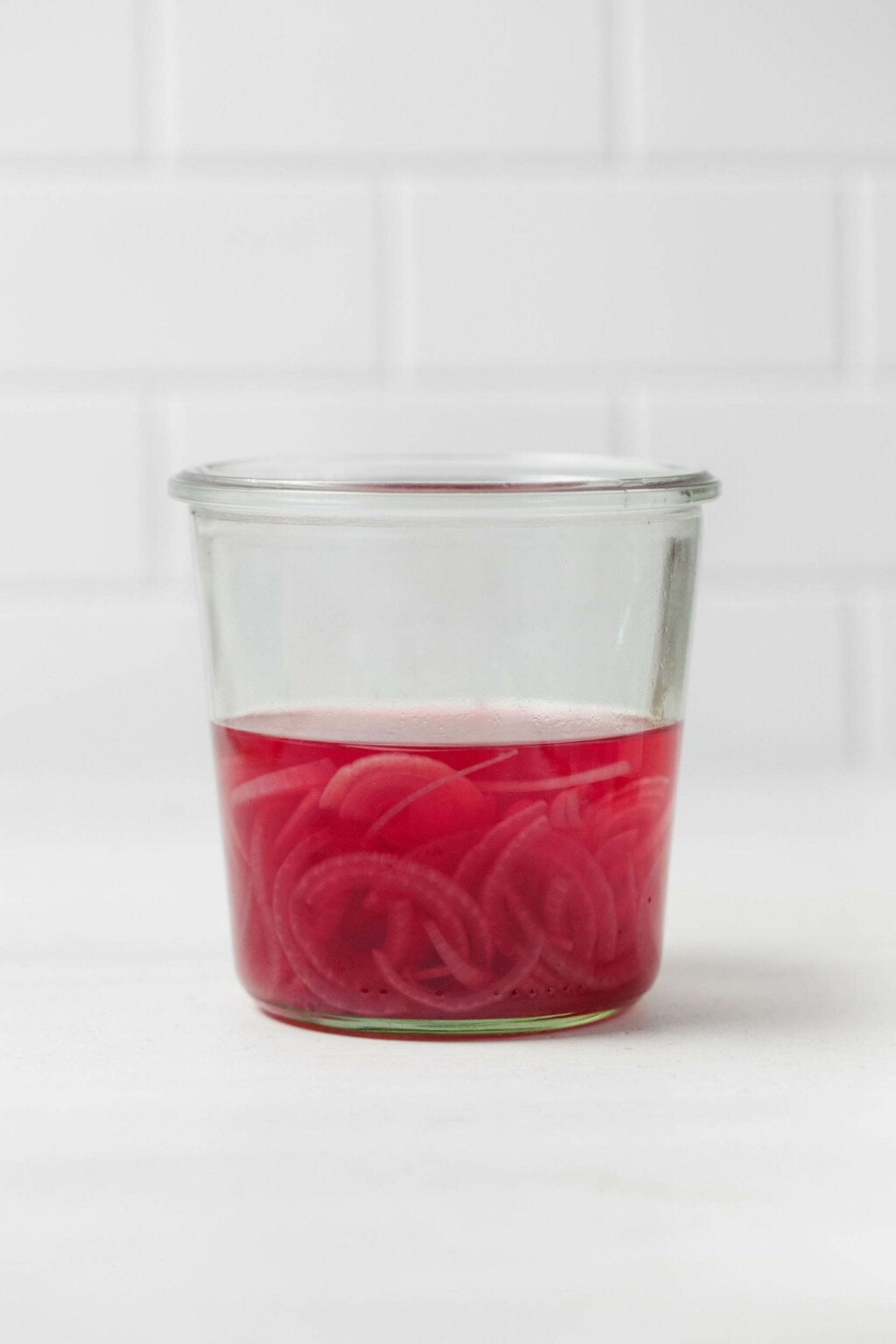
Step 4: store
At this point, you need only cover your jar and transfer the onions to the fridge. There, they’ll keep for 2-4 weeks in their pickling liquid.
Step 5: enjoy
For the weeks in which you have quick pickled onions in your fridge, you’ll be able to enjoy them in so many ways.
Think: salads, grain bowls, burritos, tacos, wraps, and so much more. I’m sharing some specific recipe ideas below.
What type of onion should I use?
This is a great question!
Personally, I like to quick pickle red onions best. But I’ve made this same recipe many times with white or yellow onion, because I had run out of red. It always works, and I always love the pickled onion flavor.
I’ve also used the same recipe to pickle shallots when I ran out of onions. That works, too.
Can I use this recipe for other vegetables?
Most definitely.
You can use this same quick pickle recipe for:
- Sliced cucumber
- Green beans
- Shaved carrot strips or thin carrot slices
- Sliced jalapeños
- Sliced radishes
- Sliced beets
- Small cauliflower florets
As you can see, many vegetables make a great quick pickle.
Recipe suggestions
Below, you’ll see some of the vegan recipes that I love to use my quick pickled onions in or on.
This list is by no means exhaustive. If you make the onions and find that you love them, then I’d say you should add them to as many dishes as you like.
However, here are some of the dishes that my pickled onions will find their way into, when I’m fortunate enough to have a jar in my fridge.
Salads
- Tahini mint kale salad
- Chickpea Greek salad
- Tempeh quinoa salad with cumin vinaigrette
- Roasted butternut squash salad with quinoa, grapes, and Brussels sprouts
Bowls
Wraps & sandwiches
Grain & bean dishes
- Cumin spiced lentils and rice
- Turmeric rice, beans & greens
- Quinoa kale stuffed sweet potato skins
- Lemon dill zucchini chickpea rice
I could probably go on and on. But instead, I’ll share the recipe.
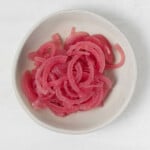
10-Minute Quick Pickled Onions
Author –Ingredients
- 1 red onion, medium size (you can also use white onion, yellow onion, or shallot)
- 3/4 cup water
- 1/2 cup vinegar (apple cider, white distilled, white wine, and rice vinegar will all work)
- 1 1/2 teaspoons kosher salt
- 2 teaspoons cane sugar (optional)
Instructions
- Bring the water, vinegar, salt, and sugar to a vigorous simmer in a sauce pot over medium high heat.
- While the pickling liquid comes to a simmer, peel, trim and slice the onion into very thin slices.
- Place the sliced onion into a wide-mouthed mason jar (at least 1 pint/480ml and up to 2 pints/950ml in volume).
- Pour the hot liquid into the mason jar and over the red onions. If all of the onions are not submerged in the pickling liquid, use a spoon to press them down into it. Their volume will decrease as they pickle.
- Cover the mason jar and transfer it to the fridge for storage. The pickles will be ready in 30 minutes and will keep in the fridge for up to 2-4 weeks.
If you’ve never made quick pickles because it seemed to you that it might be difficult, I hope this post changes your mind!
More importantly, I hope it encourages you to try making this very versatile veggie side/accompaniment. Once you get into the habit of having quick pickled onions around, you’ll likely find that you want to add them to everything.
Onions are pretty nutrient-dense, so that’s a good thing!
Experiment, enjoy, and let me know what you make.
xo
This post may contain affiliate links. If you use these links to buy something I may earn a commission. Visit my privacy policy to learn more.
Dietary Preferences: Gluten Free, No Oil, Raw, Soy Free, Tree Nut Free, Vegan
Recipe Features: 30 Minute or Less, Quick & Easy

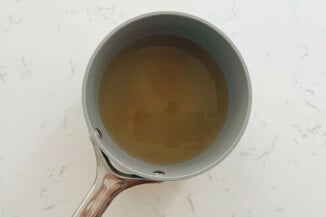
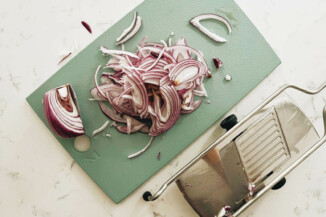
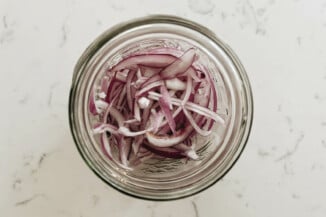
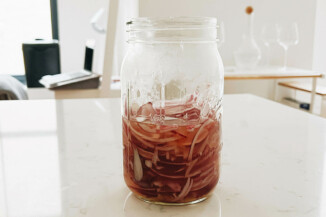
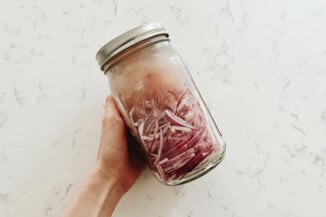
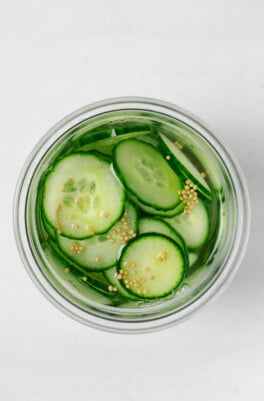
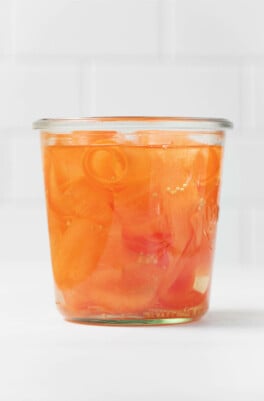
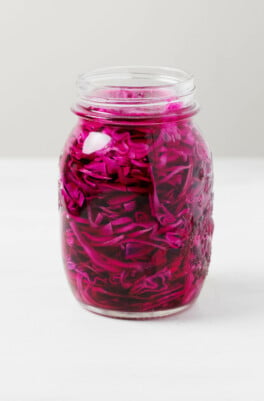
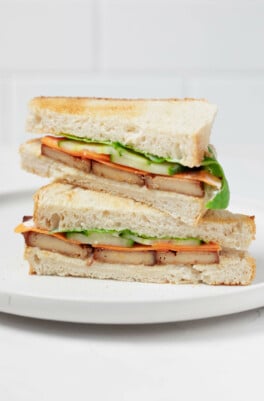
Leave a Comment
Hi Gena, Thank you for your many delicious recipes, as well as your cookbook which I love. I would like to try these pickled onions. I can eat cooked onions, but whenever I eat raw onions I get terrible acid reflux. Do you know if pickling onions neutralizes whatever is in them that causes the reflux? Thanks!
So glad that you enjoy the recipes, Jeannie 🙂
For what it’s worth, I find that raw onion repeats on me somewhat, and that effect is lessened when I use pickled onions. The acid does take some of the “bite” and sharpness out of the onions. Plus, you don’t need to use a lot of pickled onions to get a LOT of flavor. So you could try them, start with a small amount in or on food, and increase if you tolerate it well with your reflux. The thinner you slice the onions, the better.
If you find that they don’t work for you, maybe you can gift what you have left to a neighbor?
Hope this helps!
G
I love this recipe as it’s so versatile . I have even replaced the sugar for an equivalent of a sugar substitute as my daughter-in-law is a diabetic…. She loves it so much as she is also a vegan. Thank you so much for sharing this recipe . I love this on my hamburgers btw !!!!
I can confirm: From my experience, these pickled onions are amazing. We added them to a burger with sauce we made using ketchup, dijon mustard, sour cream, and salt and sugar. Absolutely DIVINE. My mouth tingled with every bite.
Thanks for sharing this recipe, which I hope lots of people will read and try. Your recipe is spot on re the proportion of ingredients, and method of preparation; perfect. As you say, so many dishes can be elevated, flavor-wise, by simply adding these thinly-sliced, quick-pickled–always red, for me–onions. A few favorite dishes to which I add these: tacos, burritos, many salads, bowls, veggie burgers, veggie hotdogs/sausages, chickpea ‘tuna’ salad wrap, Indian recipes (in place of a chutney), tofu scramble, tofu chilequiles, tofu ‘egg’ salad sandwich, tofu or tempeh stir-fry, etc. Endless possibilities. Anyone who tastes these quick-pickled onions in a recipe for the first time will quickly realize what they’ve been missing.